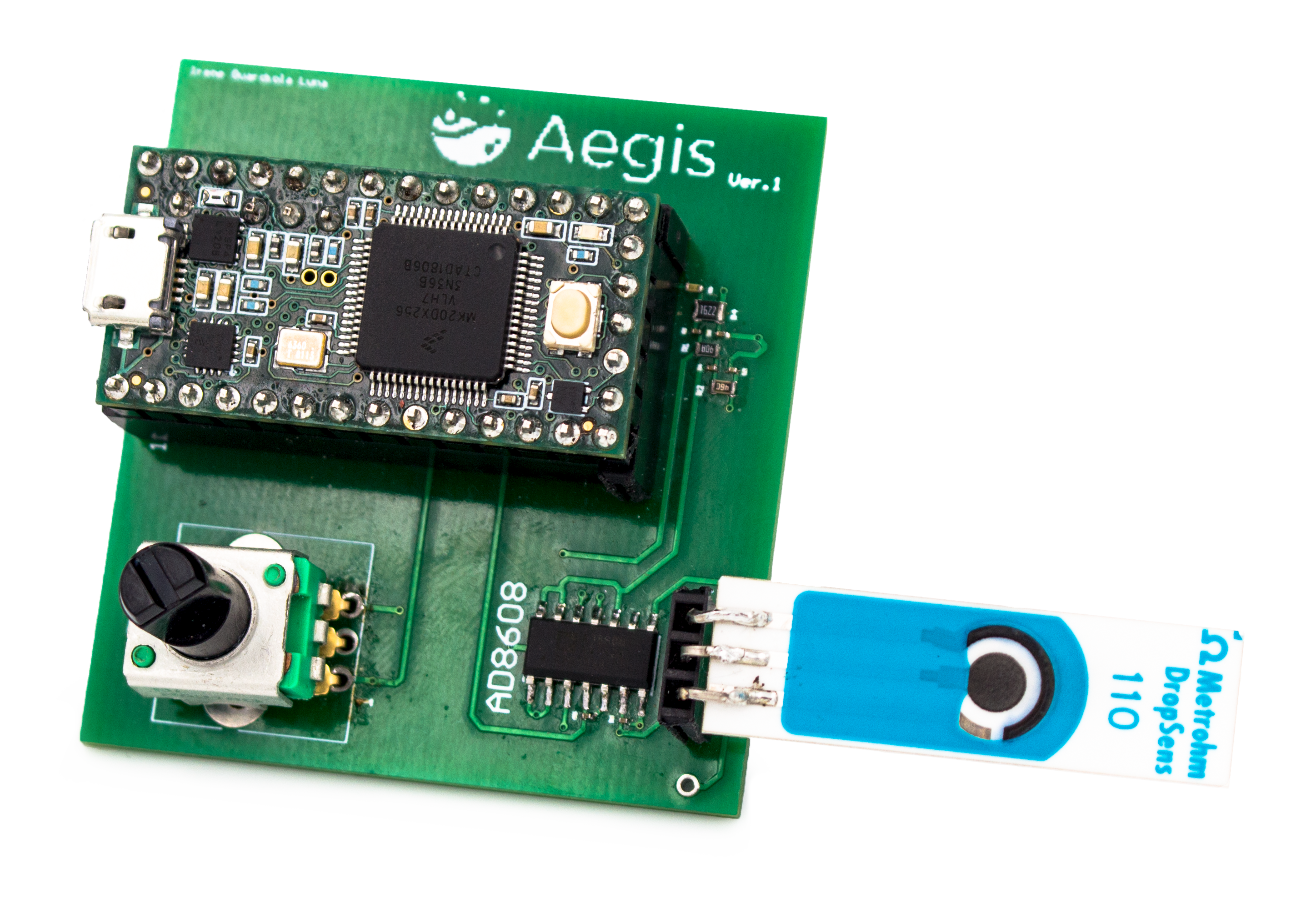Our hardware is divided into two different aspects. First, the part able to detect microorganisms in the water - in our case, the bacteria responsible for cholera disease. Second, the hardware focused on modules for the Opentrons.
This page is divided in those both sections and was made specifically to apply to answer the questions of the prize. If you want to expand the information don't hesitate to dive further in our wiki.
1 Potentiostat
We needed to make a device with which we could detect differences in potential. This does exist already, so we analysed the functionality and the way some of the existing open-source potentiostats were created.
Since the device is for areas with limited access to technology, we have constructed our potentiostat in such a way that if it stops working the most probable reason is the breakdown of the Teensy, which is not directly soldered onto the PCB and so is easy to change.
Our design has been inspired and based mainly on two different open-source potentiostats [1], [2]. Our device is designed to be used next to a computer connecting to it through a USB port.
The potentiostat works this way: the Teensy 3.2, through the DAC pin, gives us a variable input voltage from 0 to 2V. Said voltage goes through the Sallen-Key filter and later on through an operational amplifier, which is connected to the electrode, and the electrode connects to the transimpedance operational amplifier, whose output value is entered into the Teensy by the ADC pin.

We use the DAC pin to convert a digital value to an analogic one and use it as the input for the filter.
The Sallen-Key filter is used to decrease the noise. We used the same low pass filter referenced in [2].
As said in [4], with the operational amplifier connected to the electrode, we manage to keep the potential of the working electrode constant with respect to the potential of the reference electrode by adjusting the current in the counter electrode.
With the transimpedance amplifier, we are able to convert the current obtained in the working electrode to voltage and input the value into the ADC pin of the Teensy.
Our first version differed from the last one in that it had a potentiometer in the transimpedance amplifier. With this potentiometer we could change the resistor value of the transimpedance amplifier and study the changes it produces in our results. Since the rest worked well, we only changed the potentiometer for a resistor on our final design.

It allows voltammetric measurements, which include cyclic voltammetry and square wave voltammetry.
Finally, we conducted an experiment with ferricenida and got the expected results, comparing them with those obtained last year by the iGEM team Madrid-OLM.
Future Plans
Special Prize
References
[2] Ainla, A., Mousavi, M., Tsaloglou, M., Redston, J., Bell, J., Fernández-Abedul, M. and Whitesides, G. (2018). “Open-Source Potentiostat for Wireless Electrochemical Detection with Smartphones”. Analytical Chemistry, [online] 90(10), pp.6240-6246.
[3] Pjrc.com. (2019). PJRC Store. Available at: https://www.pjrc.com/store/teensy32.html
[4]D. Skoog, J. Holler and T. Nieman, Solutions manual to accompany Principles of instrumental analysis. Philadelphia: Saunders College Publ., 1998.
[5]M. Toriningen Inc.(Shingo Hisakawa, "NinjaPCR", NinjaPCR, 2019. Available: https://ninjapcr.tori.st/en/index.html.
[6] M. Dryden and A. Wheeler, "DStat: A Versatile, Open-Source Potentiostat for Electroanalysis and Integration", PLOS ONE, vol. 10, no. 10, p. e0140349, 2015.
2 Opentrons Modules
Fluorimeter
The fluorimeter consists mainly of 4 LEDs of different wavelengths, 2 optical filters, 4 photodetectors and a microcontroller.
The wavelengths of the LEDs are: 405nm, 473nm, 532nm and 600nm.
The optical filters are bandpass and we used them to filter the wavelengths of the second and third LED. The wavelengths of the filters are: 532nm and 568nm.
With this design, LEDs can only work one by one.

Future Plans
Shaker Module
We could achieve this using a stepper motor controlled with a driver, with which we could input pulses. We also included magnets and Hall sensors to know exactly where the plate is in the movement, and hence know that when you pass once through the three magnets, that is your point of origin and end.
To program it we use the open-source Arduino software and a driver to switch from USB to UART.

Future Plans
Wax Module
Analogue of the Shaker Module, this can also be programmed with the Arduino software and a driver.


PCR and Thermal Modules
To maintain those temperatures, we used peltier cells controlled with a PID controller.


The servomotor is connected to a 5V power supply and to the TX pin of the PCB.
Once we had the motor, we made a scaffold with a 3D printer.
Analogue to the previous modules, this can also be programmed with the Arduino software and a driver.
Future Plans
Special Prize
References
[2] Ainla, A., Mousavi, M., Tsaloglou, M., Redston, J., Bell, J., Fernández-Abedul, M. and Whitesides, G. (2018). “Open-Source Potentiostat for Wireless Electrochemical Detection with Smartphones”. Analytical Chemistry, [online] 90(10), pp.6240-6246.
[3] Pjrc.com. (2019). PJRC Store. Available at: https://www.pjrc.com/store/teensy32.html
[4]D. Skoog, J. Holler and T. Nieman, Solutions manual to accompany Principles of instrumental analysis. Philadelphia: Saunders College Publ., 1998.
[5]M. Toriningen Inc.(Shingo Hisakawa, "NinjaPCR", NinjaPCR, 2019. Available: https://ninjapcr.tori.st/en/index.html.
[6] M. Dryden and A. Wheeler, "DStat: A Versatile, Open-Source Potentiostat for Electroanalysis and Integration", PLOS ONE, vol. 10, no. 10, p. e0140349, 2015.





